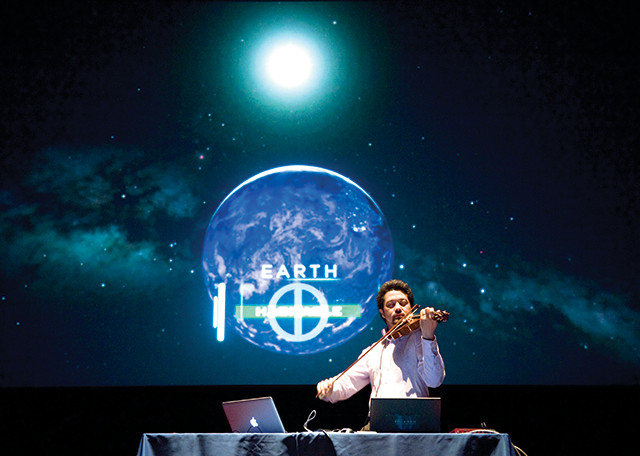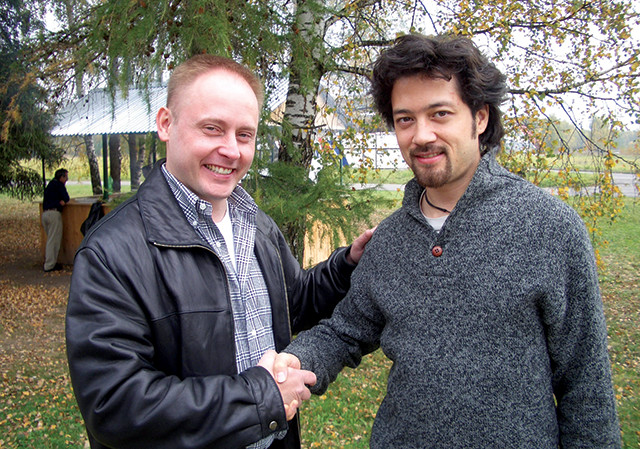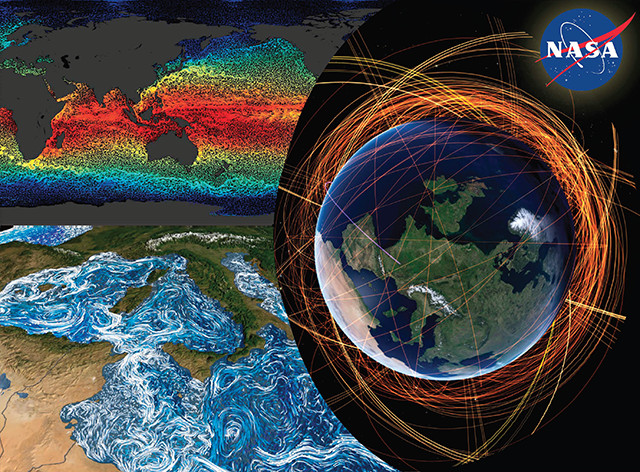
by Lucas Joel Friday, April 22, 2016

Bella Gaia is a live performance featuring music, dance and NASA satellite imagery of Earth. Credit: NASA.
On the screen, images of the far reaches of the cosmos — galaxies, stellar nebulae and supernovae — loom high over a stage. The words, “The Living Universe,” appear and the view zooms in: first on our galaxy, then on our solar system and, finally, on Earth. Bella Gaia, a live performance piece featuring dance and music set in front of a large projection-screen displaying images of Earth from space, begins.
The show’s creator and composer, Kenji Williams, likens it to Cirque du Soleil, but with a focus on earth science. The aim, Williams says, is to draw connections between life on Earth — particularly human life — and the wider universe. This is not easy to do, as much of our planet, not to mention the cosmos, is generally beyond our sight. Explaining what climate is, for instance, is complicated because it is invisible and borderless, making it difficult for people to grasp.
Williams, who studied music and filmmaking and who plays violin during the show, says he sees the performance as a way to entertain but also educate people about Earth. “Large, interconnected concepts like climate change are … [often] communicated in such abstract ways with figures and graphs,” Williams says. Conveying what something like climate change “has to do with your life today, right now, in your family — that takes an emotional vehicle, and Bella Gaia plays that role.”

U.S. astronaut Michael Fincke (left) and Bella Gaia creator Kenji Williams. Credit: Bella Gaia.
The path to producing Bella Gaia began with a chance meeting between Williams and astronaut Michael Fincke at the launch of a Soyuz spacecraft in Russia. Fincke told Williams about his experiences as an astronaut, and about the impact of viewing Earth from space. “He told me that before he went into space his favorite planets were Mars, Jupiter and Saturn,” Williams says. “But when he looked out the windows of the space station and saw our Earth — with a thin atmosphere and as a beautiful, borderless living bubble of life in the blackness of space — he had a transformation, and Earth became his favorite planet.” What Fincke experienced, Williams explains, is sometimes called the overview effect, which describes the sensation felt by astronauts who behold Earth from space and begin to see the planet as one interconnected whole rather than a place composed of isolated parts. “This very simple realization that astronauts have, that is what I want to replicate [with Bella Gaia] for those of us who cannot go into space.”
On screen, the camera follows an orbital path of the International Space Station (ISS) around Earth, and, at various intervals, different astronauts speak about their own experiences with the overview effect. Astronaut Edgar Mitchell briefly narrates: “My view of our planet was a glimpse of divinity.”

NASA images used during Bella Gaia performances depict oceanic currents (left) and orbital paths of the International Space Station (right). Credit: NASA.
NASA imagery includes photorealistic renderings of the planet, many of which illustrate aspects of earth processes such as the swirling paths of ocean currents. Like a multitude of animated paintbrush strokes, the currents are both educational and splendid to behold: Ocean currents play a major role in transporting heat around the planet, and seeing them move as they do in Bella Gaia would be a useful teaching aid in any earth science classroom.
As the ocean currents and other imagery swirl on screen, the music, all composed by Williams, provides a surreal, ambient backdrop. Vocal and instrumental passages blend into each other and produce a dreamlike, fluid sound. In this way, the music reflects the view of Earth that Bella Gaia seems to take: borderless and interconnected. The music, along with the dancers on stage — who often sport colors reflective of those displayed simultaneously on screen — help the viewers connect with the imagery.
Although beautifully rendered, some of the show’s sequences, at least in the version of Bella Gaia that I saw, did not clearly convey the message it seemed they were meant to. One sequence showed the distribution of wildfires across the Amazon rainforest: While this may have been intended to communicate the connection between human activity and an increase in wildfire occurrence, the connection was not totally obvious.
As the ISS continues its orbit, Bella Gaia “visits” different locales around the world, such as Egypt and New York City. These stops feature music and dancing reflective of each region’s particular culture, which, Williams says, is an attempt to connect human culture with the universe on display via NASA’s imagery. “All cultures are on stage, everybody’s welcome, and it’s a nonexclusive [space where we can experience] our connection to the natural world and the cosmos.”
© 2008-2021. All rights reserved. Any copying, redistribution or retransmission of any of the contents of this service without the expressed written permission of the American Geosciences Institute is expressly prohibited. Click here for all copyright requests.